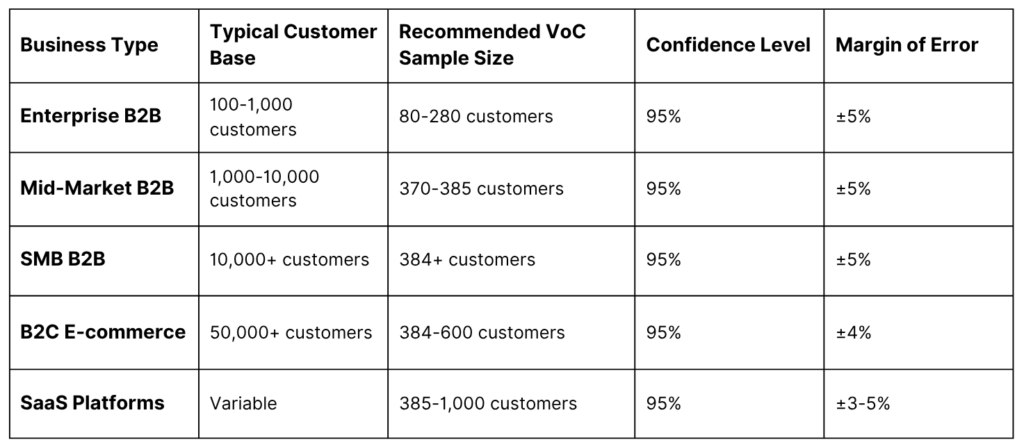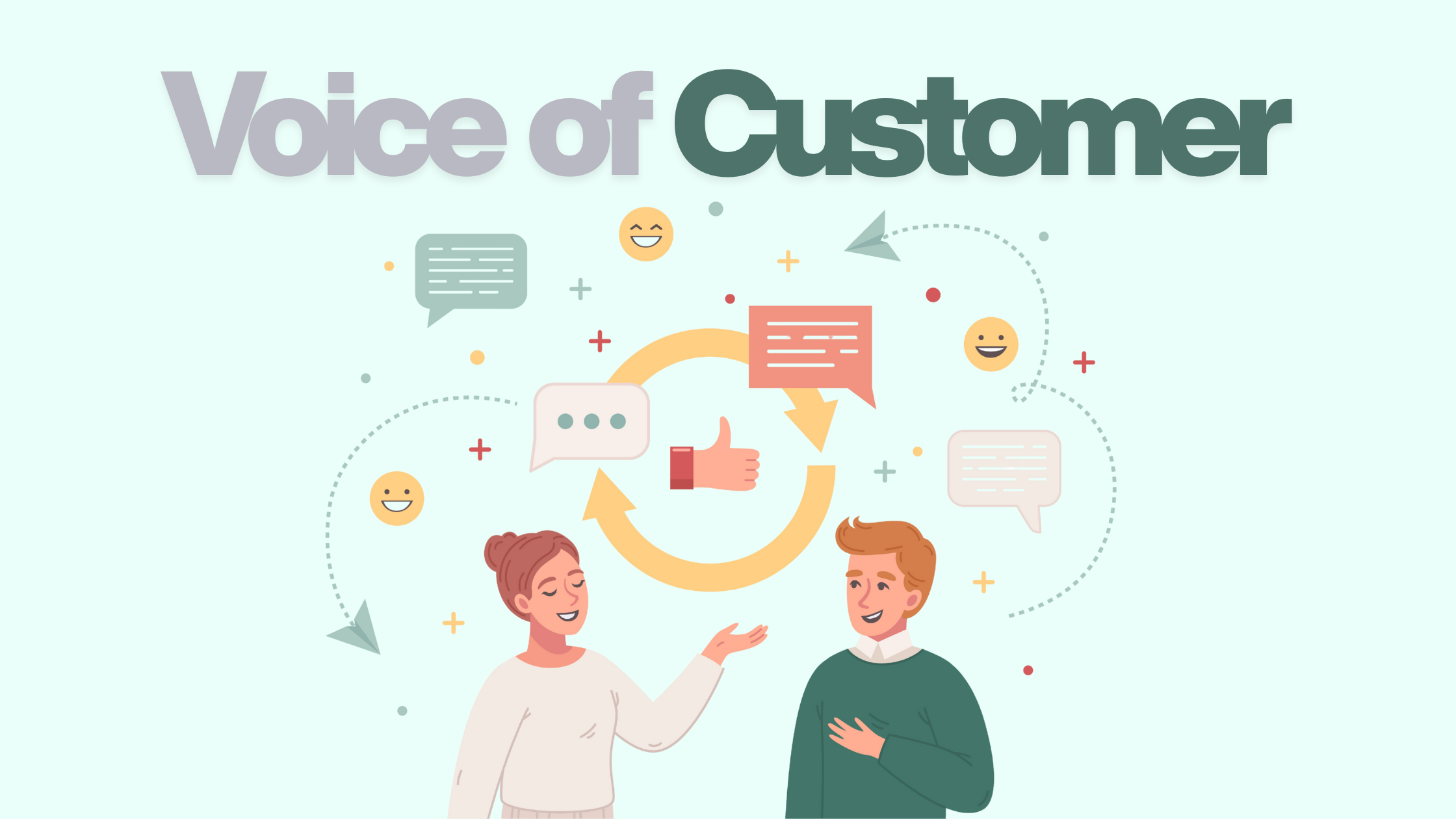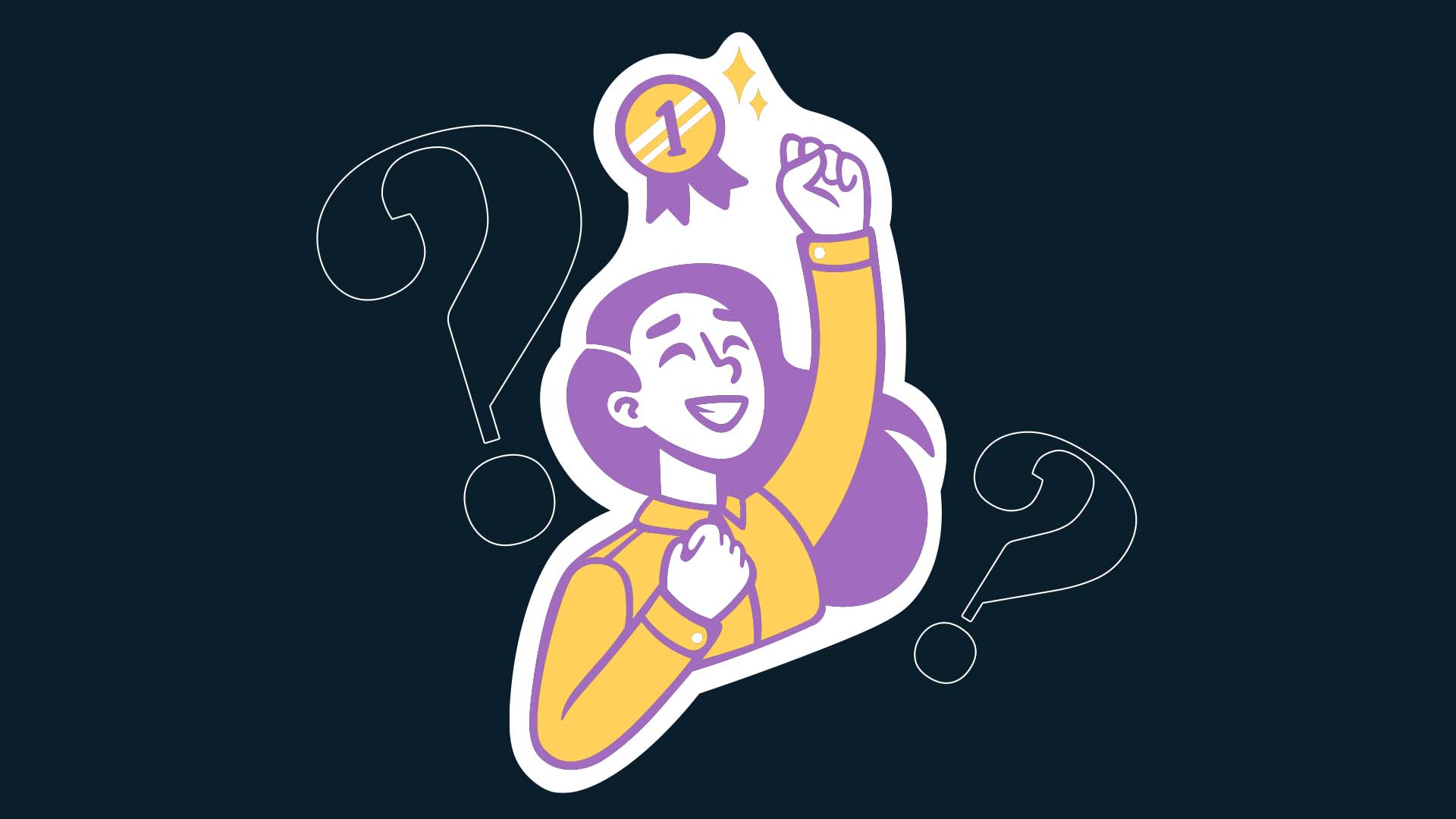Introduction
Launching a Voice of Customer program is one of the smartest investments a business can make. But here’s the million-dollar question that keeps CX leaders up at night: “How many customers do I actually need to survey to get reliable insights?”
The answer isn’t as simple as “the more, the better.” Your customer sample size directly impacts budget, response fatigue, data quality, and ultimately, the business decisions you’ll make based on those insights.
Getting your customer sample size wrong can lead to:
Too small: Unreliable data that misleads strategic decisions
Too large: Survey fatigue, wasted budget, and diminishing returns
Just right: Statistically significant insights that drive real business impact
In this guide, we’ll help you:
1. Understand the statistical foundations of Customer sample sizing
2. Calculate optimal sample sizes for different Customer scenarios
3. Avoid common mistakes that undermine Voice of Customer program effectiveness
4. Implement best practices used by successful US businesses
Understanding Sample Size Fundamentals
What Makes Sample Size Different?
Unlike academic research, customer listening programs have unique considerations:
Business Context Matters: Your sampling needs depend on how you’ll use the insights—strategic decisions require higher confidence than operational tweaks.
Customer Segmentation: Most programs need representative samples across different customer segments, not just overall population insights.
Ongoing vs. One-Time: Continuous measurement affects how you approach numbers over time.
Action Orientation: Insights must be precise enough to guide resource allocation and strategic shifts.
Statistical Foundations for Sample Size
Key Statistical Concepts to Understand
Confidence Level: How certain you want to be that your Voice of Customer results reflect reality
1. 90% confidence: Acceptable for operational decisions
2. 95% confidence: Standard for most programs
3. 99% confidence: Required for major strategic initiatives
Margin of Error: How much deviation you can accept in your results
1. ±1%: Extremely precise (often unnecessary and expensive)
2. ±3%: High precision for critical metrics
3. ±5%: Standard for most applications
4. ±10%: Acceptable for exploratory research
Population Size: Your total customer base affects sample size calculations, but less than most people think.
Basic Voice of Customer Sample Size Formula
For simple random sampling in programs:
n = (Z² × p × (1-p)) / E²
Where:
- n = Voice of Customer sample size needed
- Z = Z-score for desired confidence level
- p = Expected proportion (use 0.5 if unknown)
- E = Margin of error (as decimal)
Example:
- Confidence level: 95% (Z = 1.96)
- Margin of error: ±5% (E = 0.05)
- Expected proportion: 50% (p = 0.5)
n = (1.96² × 0.5 × 0.5) / 0.05² = 384 customers
Sample Size by Business Type and Goals
Sample Sizes for Different Business Models

Sample Size by Program Objectives
Strategic Initiatives (Major business decisions)
1. Sample size: 600-1,000+ customers
2. Confidence level: 99%
3. Margin of error: ±3%
4. Use case: Product roadmap decisions, market entry, pricing strategy
Operational Programs (Process improvements)
1. Sample size: 300-400 customers
2. Confidence level: 95%
3. Margin of error: ±5%
4. Use case: Service quality monitoring, feature feedback, support optimization
Pulse Surveys (Quick health checks)
1. Sample size: 150-250 customers
2. Confidence level: 90%
3. Margin of error: ±6-8%
4. Use case: Monthly NPS tracking, post-interaction feedback
Advanced Voice of Customer Sample Size Considerations
1. Segmentation Impact on Sample Size
Most programs need insights by customer segment. This dramatically affects sample size requirements:
Single Segment Analysis: Use standard sample size calculations
Multiple Segment Analysis: Each segment needs its own adequate sample size
Example:
Overall sample needed: 384 customers
Number of segments: 4 (Enterprise, Mid-market, SMB, Startup)
Sample per segment: 96 customers minimum
Total sample needed: 384 × 4 = 1,536 customers
2. Response Rate Impact on Sample Size
Your sample size calculation must account for expected response rates:
Voice of Customer Response Rates by Channel:
Email surveys: 10-25%
SMS surveys: 15-35%
In-app surveys: 20-40%
Phone interviews: 5-15%
Post-interaction surveys: 25-50%
Calculating Required Invitations: If you need 384 completed responses and expect a 20% response rate:
Required invitations = 384 ÷ 0.20 = 1,920 customers
3. Finite Population Correction for Voice of Customer Programs
When your sample represents more than 5% of your customer base, use the finite population correction:
Adjusted n = n / (1 + ((n-1) / N))
Where:
- n = Initial customer sample size
- N = Total customer population
Example:
Calculated sample size: 384
Total customers: 2,000
384 ÷ 2,000 = 19.2% (>5%, so correction needed)
Adjusted sample = 384 ÷ (1 + (383 ÷ 2,000)) = 323 customers
Industry Best Practices
1. Technology/SaaS Programs
Recommended approach: Larger samples for statistical power
1. New feature testing: 500-800 customers
2. User experience: 400-600 customers
3. Churn prediction: 1,000+ customers
4. Pricing strategy: 600-1,000 customers
Why larger samples: Tech customers are diverse, usage patterns vary significantly, and product decisions impact revenue directly.
2. Financial Services Programs
Recommended approach: High confidence, regulatory considerations
1. Service quality: 600-800 customers
2. Product development: 800-1,200 customers
3. Regulatory focus: 1,000+ customers
4. Branch experience: 300-500 per location
Why high confidence: Regulatory scrutiny, high customer lifetime value, and significant switching costs require precise insights.
3. Healthcare Voice of Customer Programs
Recommended approach: Balanced precision with patient privacy
1. Patient satisfaction: 400-600 patients
2. Provider experience: 200-400 providers
3. Service improvement: 300-500 patients
4. Digital health: 500-800 users
Special considerations: HIPAA compliance limits some approaches, but insights are critical for patient outcomes.
4. Retail/E-commerce Voice of Customer Programs
1. Recommended approach: Large samples, seasonal considerations
2. Shopping experience: 600-1,000 customers
3. Product feedback: 400-600 customers
4. Loyalty program: 500-800 members
5. Omnichannel: 800-1,200 customers
Why larger samples: Diverse customer base, seasonal variations, and multiple touchpoints require robust Voice of Customer data.
Common Voice of Customer Sample Size Mistakes to Avoid
Mistake #1: Using Academic Research Standards
The Problem: Academic research often uses different confidence levels and margins of error than business Voice of Customer programs need.
The Solution: Focus on business impact rather than statistical perfection. A 95% confidence level with ±5% margin of error is sufficient for most Voice of Customer applications.
Mistake #2: Ignoring Segmentation Requirements
The Problem: Calculating overall Voice of Customer sample size without considering segment-level analysis needs.
The Solution: Determine required sample sizes for each customer segment you’ll analyze separately.
Mistake #3: Forgetting About Response Rates
The Problem: Planning to survey exactly the number of customers in your Voice of Customer sample size calculation.
The Solution: Always account for expected response rates when determining invitation volumes.
Mistake #4: One-Size-Fits-All Voice of Customer Approach
The Problem: Using the same Voice of Customer sample size for strategic decisions and operational feedback.
The Solution: Match your Voice of Customer sample size to the importance and risk of decisions you’ll make with the data.
Mistake #5: Oversampling Without Purpose
The Problem: Thinking bigger Voice of Customer samples are always better, regardless of cost or survey fatigue.
The Solution: Calculate the minimum statistically valid Voice of Customer sample size and add buffer based on specific risks.
Practical Voice of Customer Sample Size Strategies
Strategy 1: Tiered Sampling
Use different sample sizes for different Voice of Customer objectives:
Tier 1 – Strategic Voice of Customer (Quarterly)
1. Sample size: 800-1,200 customers
2. All segments represented
3. High statistical confidence
Tier 2 – Operational Voice of Customer (Monthly)
1. Sample size: 400-600 customers
2. Focus on key segments
3. Standard confidence levels
Tier 3 – Pulse Voice of Customer (Weekly)
1. Sample size: 150-300 customers
2. Rapid insights
3. Acceptable confidence for trends
Strategy 2: Progressive Voice of Customer Sampling
Start with smaller Voice of Customer samples and expand based on initial findings:
Phase 1: 200-300 customers for directional insights
Phase 2: If results show concerning trends, expand to 500-600 customers
Phase 3: For major decisions, reach 800-1,000+ customers
Strategy 3: Continuous Voice of Customer Sampling
Instead of large periodic surveys, use ongoing smaller Voice of Customer samples:
Daily collection: 10-20 responses
Weekly analysis: 70-140 responses
Monthly reporting: 300-600 responses
Quarterly strategy: 900-2,400 responses
Technology’s Impact on Voice of Customer Sample Size
AI and Machine Learning in Voice of Customer Programs
Modern platforms like Zykrr use AI to extract more insights from smaller samples:
1. Text Analytics: AI can identify themes and sentiment from open-ended responses, increasing the value of each customer response.
2. Predictive Models: Machine learning can identify patterns with smaller datasets than traditional statistical methods.
3. Real-Time Adjustment: AI can adjust customer sampling strategies based on response quality and emerging patterns.
Result: You may achieve reliable customer insights with 20-30% smaller sample sizes when using advanced analytics.
Platform Capabilities and Voice of Customer Sample Size
Your Voice of Customer platform affects optimal sample sizes:
1. Basic Platforms: Need larger Voice of Customer samples to compensate for limited analytics
2. Advanced Platforms: Can extract more insights from smaller Voice of Customer samples
3. AI-Powered Platforms: May reduce required Voice of Customer sample sizes through intelligent analysis
How Zykrr Optimizes Voice of Customer Sample Sizes
Zykrr’s Voice of Customer platform helps US businesses get maximum insights from optimal sample sizes:
Smart Sampling Features:
1. Automated Calculation: Built-in Voice of Customer sample size calculators based on your goals
2. Segment Optimization: Ensures adequate Voice of Customer sample sizes across all customer segments
3. Response Rate Prediction: Historical data predicts Voice of Customer response rates for accurate planning
4. Progressive Sampling: Start small and expand Voice of Customer samples based on initial results
AI-Enhanced Analysis:
1. Theme Detection: Extract maximum insights from every Voice of Customer response
2. Sentiment Analysis: Understand customer emotions with smaller Voice of Customer samples
3. Predictive Analytics: Identify trends and patterns more efficiently
4. Quality Scoring: Focus on high-quality customer responses for better insights
Real Results: A mid-market software company using Zykrr reduced their required Voice of Customer sample size by 35% while increasing insight quality by leveraging AI-powered analysis.
Discover How Zykrr Can Optimize Your Voice of Customer Sample Size →
Voice of Customer Sample Size Calculator Framework
Use this framework to determine your optimal Voice of Customer sample size:
Step 1: Define Your Objectives
1. Strategic decisions: Use 99% confidence, ±3% margin of error
2. Operational improvements: Use 95% confidence, ±5% margin of error
3. Trend monitoring: Use 90% confidence, ±7% margin of error
Step 2: Identify Segments
1. List all customer segments you need insights for
2. Determine minimum sample size per segment (usually 80-100)
3. Calculate total customer sample size needed
Step 3: Account for Response Rates
1. Estimate Voice of Customer response rate based on channel and audience
2. Calculate required invitation volume
3. Plan for 10-20% buffer above minimum requirements
Step 4: Validate with Business Context
1. Budget constraints: Can you afford the calculated Voice of Customer sample size?
2. Timeline requirements: Do you have time to collect required responses?
3. Survey fatigue: Will this Voice of Customer sample size over-burden customers?
Frequently
Asked Questions
-
What’s the minimum sample size for directional insights?
For most business applications, 200-300 customers provides directional insights, but 400+ customers gives reliable statistical significance for customer programs.
-
How does customer base size affect customer sample size?
Surprisingly little. A sample of 384 customers provides similar confidence whether your base is 5,000 or 50,000 customers (though finite population correction applies for smaller bases).
-
Should customer sample size vary by customer segment?
Yes, each segment you analyze separately needs its own adequate customer sample size—typically 80-100 customers minimum per segment.
-
How often should I recalculate customer sample size requirements?
Review your customer sample size strategy quarterly, or whenever your customer base, objectives, or confidence requirements change significantly.
-
Can AI reduce required customer sample sizes?
Advanced AI can extract more insights from smaller customer samples, potentially reducing requirements by 20-30% while maintaining insight quality.
-
What if I can’t achieve my calculated sample size?
Use the largest representative customer sample possible, clearly communicate confidence limitations, and consider qualitative research to supplement quantitative insights.





















